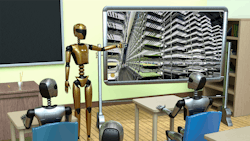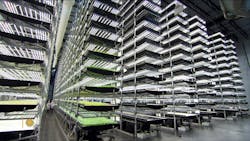What’s the Difference Between Vertical Farming and Machine Learning?
What you’ll learn
- What is vertical farming?
- Why is this author comparing it to machine learning?
- Is there really any relationship between these two things?
Sometimes inspiration comes in the oddest ways. I like to watch CBS News Sunday Morning because of the variety of stories they air. Recently, they did one on “Vertical Farming - A New Form of Agriculture” (see video below).
CBS News Sunday Morning recently did a piece on vertical farming that spawned this article.
For those who didn’t watch the video, vertical farming is essentially a method of indoor farming using hydroponics. Hydroponics isn’t new; it’s a subset of hydroculture where crops are grown without soil. Instead, the plants grow in a mineral-enriched water. This can be done in conjunction with sunlight but typically an artificial light source is used.
The approach is useful in areas that don’t provide enough light, or at times or in locations where the temperature or conditions outside would not be conducive for growing plants.
Vertical farming is hydroponics taken to the extreme, with stacks upon stacks of trays with plants under an array of lights. These days, the lights typically are LEDs because of their efficiency and the ability to generate the type of light most useful for plant growth. Automation can be used to streamline planting, support, and harvesting.
A building can house a vertical farm anywhere in the world, including in the middle of a city. Though lots of water is required, it’s recycled, making it more efficient than other forms of agriculture.
Like many technologies, the opportunities are great if you ignore the details. That’s where my usual contrary nature came into play, though, since I followed up my initial interest by looking for limitations or problems related to vertical farming. Of course, I found quite a few and then noticed that many of the general issues applied to another topic I cover a lot—machine learning/artificial intelligence (ML/AI).
If you made it this far, you know how I’m looking at the difference between machine learning and vertical farming. They obviously have no relationship in terms of their technology and implementation, but they do have much in common when one looks at the potential problems and solutions related to those technologies.
As electronic system designers and developers, we constantly deal with potential solutions and their tradeoffs. Machine learning is one of those generic categories that has proven useful in many instances. However, one must be wary of the issues underlying those flashy approaches.
Experts Wanted
Vertical farming, like machine learning, is something one can dabble in. To be successful, though, it helps to have an expert or at least someone who can quickly gain that experience. This tends to be the case with new and renewed technologies in general. I suspect significantly more ML experts are available these days for a number of reasons like the cost of hardware, but the demand remains high.
Vertical farming uses a good bit of computer automation. The choice of plants, fertilizers, and other aspects of hydropic farming are critical to the success of the farm. Then there’s the maintenance aspect. ML-based solutions are one way of reducing the expertise or time required by the staff to support the system.
ML programmers and developers also are able to obtain easier-to-use tools, thereby reducing the amount of expertise and training required to take advantage of ML solutions. These tools often incorporate their own ML models, which are different than those being generated.
Profitable for Only a Few Types of Plants
Hydroponics works well for many plants, but unfortunately for multiple others, that’s not the case. For example, crops like microgreens work well. However, a cherry or apple tree often struggles with this treatment.
ML suffers from the same problem in that it’s not applicable to all computational chores. But, unlike vertical farms, ML applications and solutions are more diverse. The challenge for developers comes down to understanding where ML is and isn’t applicable. Trying to force-fit a machine-learning model to handle a particular problem can result in a solution that provides poor results at high cost.
High Power Consumption
Vertical farms require power for lighting and to move liquid. ML applications tend to do lots of computation and thus require a good deal of power compared to other computational requirements. One big difference between the two is that ML solutions are scalable and hardware tradeoffs can be significant.
For example, ML hardware can improve performance that’s orders of magnitude better than software solutions while reducing power requirements. Likewise, even software-only solutions may be efficient enough to do useful work even while using little power, simply because developers have made the ML models work within the limitations of their design. Vertical farms do not have this flexibility.
High Investment and Running Costs
Large vertical farms do require a major investment, and they’re not cheap to run due to their scale. The same is true for cloud-based ML solutions utilizing the latest in disaggregated cloud-computing centers. Such data centers are leveraging technologies like SmartNIC and smart storage to use ML models closer to communication and storage than was possible in the past.
The big difference with vertical farming versus ML is scalability. It’s now practical for multiple ML models to be running in a smartwatch with a dozen sensors. But that doesn’t compare to dealing with agriculture that must scale with the rest of the physical world requirements, such as the plants themselves.
Still, these days, ML does require a significant investment with respect to development and developing the experience to adequately apply ML. Software and hardware vendors have been working to lower both the startup and long-term development costs, which has been further augmented by the plethora of free software tools and low-cost hardware that’s now generally available.
Technology Failure Can Lead to Major Problems
Cut the power on a vertical farm and things come to a grinding halt rather quickly, although it’s not like having an airplane lose power at 10,000 feet. Still, plants do need sustenance and light, though they’re accustomed to changes over time. Nonetheless, responding to failures within the system is important to the system’s long-term usefulness.
ML applications tend to require electricity to run, but that tends to be true of the entire system. A more subtle problem with ML applications is the source of input, which is typically sensors such as cameras, temperature sensors, etc. Determining whether the input data is accurate can be challenging; in many cases, designers simply assume that this information is accurate. Applications such as self-driving cars often use redundant and alternative inputs to provide a more robust set of inputs.
Changing Technology
Vertical-farming technology continues to change and become more refined, but it’s still maturing. The same is true for machine learning, though the comparison is like something between a penny bank and Fort Knox. There are simply more ML solutions, many of which are very mature with millions of practical applications.
That said, ML technologies and applications are so varied, and the rate of change so large, that keeping up with what’s available—let alone how things work in detail—can be overwhelming.
Vertical farming is benefiting from advances in technology from robotics to sensors to ML. The ability to track plant growth, germination, and detecting pests are just a few tasks that apply across all of agriculture, including vertical farming.
Wrapping Up
As with many “What’s the Difference” articles, the comparisons are not necessarily one-to-one, but hopefully you picked up something about ML or vertical farms that was of interest. Many issues don’t map well, like problems of pollination for vertical farms. Though the output of vertical farms will likely feed some ML developers, ML is likely to play a more important part in vertical farming given the level of automation possible with sensors, robots, and ML monitoring now available.
About the Author
William G. Wong
Senior Content Director - Electronic Design and Microwaves & RF
I am Editor of Electronic Design focusing on embedded, software, and systems. As Senior Content Director, I also manage Microwaves & RF and I work with a great team of editors to provide engineers, programmers, developers and technical managers with interesting and useful articles and videos on a regular basis. Check out our free newsletters to see the latest content.
You can send press releases for new products for possible coverage on the website. I am also interested in receiving contributed articles for publishing on our website. Use our template and send to me along with a signed release form.
Check out my blog, AltEmbedded on Electronic Design, as well as his latest articles on this site that are listed below.
You can visit my social media via these links:
- AltEmbedded on Electronic Design
- Bill Wong on Facebook
- @AltEmbedded on Twitter
- Bill Wong on LinkedIn
I earned a Bachelor of Electrical Engineering at the Georgia Institute of Technology and a Masters in Computer Science from Rutgers University. I still do a bit of programming using everything from C and C++ to Rust and Ada/SPARK. I do a bit of PHP programming for Drupal websites. I have posted a few Drupal modules.
I still get a hand on software and electronic hardware. Some of this can be found on our Kit Close-Up video series. You can also see me on many of our TechXchange Talk videos. I am interested in a range of projects from robotics to artificial intelligence.


